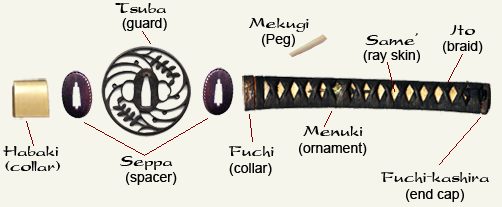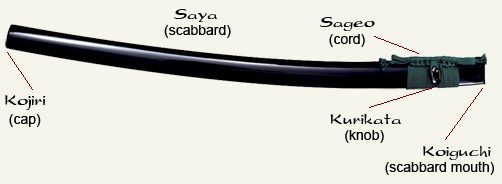By Lyuesword | 02 July 2020 | 0 Comments
PARTS OF THE KATANA KOSHIRAE
Katana Parts and Components
Main Katana Parts
First, a katana has three main parts.
Blade – Steel component of the katana which is used for cutting.
Tsuka – The handle of the sword.
Saya – Scabbard of the sword used to protect the blade.
First, a katana has three main parts.
Blade – Steel component of the katana which is used for cutting.
Tsuka – The handle of the sword.
Saya – Scabbard of the sword used to protect the blade.
Katana Components: In-Depth
In this section, you will find detailed information on the three main categories of a samurai sword.
Blade
Obviously, the blade is the most important component of a sword.

Nakago — The nakago is the tang of the sword, which is hidden underneath the handle.
Mei — Signature of the dealer, usually on the Nakago (shaft).
Hasaki — also called Ha, is the tempered cutting edge of the blade.
Mune — The mune is exactly the opposite of the hasaki. Opposite of a sharp edge used for cutting it is the blunt back edge of the blade.
Hi (Bo-hi) — The hi is a groove carved into the blade. Like the fuller of a medieval sword, its primary function is to reduce the weight of the sword.
Hamon — The hamon line is a side-effect of clay tempering the blade. By differentially tempering a sword a line is created that separates the part of the sword that was covered in clay and the uncovered part.
Shinogi — The shinogi is the ridge running along the the sword. Typically it is closer to the back (mune) than to the cutting edge (hasaki). At this line the blade transitions from the angled portion of the cutting edge to the flat section from the back of the sword. (Blades that do not have a shinogi are called Hira-Zukuri.)
Ji — This is the part of the sword between the ridge (shinogi) and the temper line (hamon).
Shinogi-Ji — The Shinogi-Ji is the area between the shinogi and the mune (back).
Yokote — The Yokote is the dividing line between the kissaki (point) and the body of the blade. Most katanas have a yokote although there are some exceptions. On some katana types, the tip of the blade is rather used for slicing instead of thrusting.
Boshi — The Boshi is the temper line of the kissaki. Only differentially hardened katanas have a temper line.
Kissaki — The kissaki is the point of the blade.
Sori — The sori is not a real part of the sword. It measures the curvature of the blade.
Nagasa — The nagasa is just a measurement of a specific property. The nagasa indicates the length of the blade.
It is measured in a straight line from the kissaki (point) to the habaki (metal collar)
Tsuka
The tsuka is the other main part of the katana. The tsuka represents the handle of the sword.

Habaki — This is the metal collar located at the base of the blade. Although this part is quite small they serve a very important function. They support the stability of the sword during its storage in the scabbard.
Seppa — These tiny metal pieces are located on both sides of the guard (tsuba). They primarily serve as spacers.
Tsuba — The tsuba is the guard of the sword. In general, the tsuba is round and square. Furthermore, it is quite common to decorate the tsuba. There are a lot of awesome designs for the guards from lyuesword.
Fuchi- The fuchi is the collar between the guard and the handle of the sword. This ornament often features nature motives.
Mekugi — These are the small pegs that fix the swords tang (nakago) underneath the hilt. They are made of wood. Flexibility of this component is very important. When the sword gets impacted by a strike the mekugi should not break.
Menuki — The menuki are small decorative sculptures. Most of the time they are depicting animals or mythological creatures, such as dragons. These ornaments are meant to fit into the palm to increase the grip.
ITO — The tsuka-ito is the wrapping of the tsuka (handle). The tsukaito is created from silk or cotton, and sometimes leather.
SameKawa — This is the ray or shark skin wrapping the handle of the sword. It is located under the tsuka-ito.
Kashira — This kashira is the last part of the katana. The European equivalent is called pommel. The kashira has a tiny hole, which is important in the makidome process.
Makidome — Makidome is the last process of wrapping the tsuka-ito silk around the hilt. The tsuka-ito normally forms a knot on one side of the tsuka (handle). The wrapping then goes through the kashira forming the final knot.
Tsukamaki — Tsukamaki describes the technique used to wrap the tsuka-ito around the handle (tsuka). There are many kinds of Tsukamaki wrap. I'll post in the next article.
Saya
The saya is the scabbard of the katana. Normally it is manufactured from very lightweight wood with a coat of lacquer on the exterior.

Koiguchi — Koiguchi represents the scabbard mouth. When the sword is in the saya the koiguchi has direct contact with the habaki.
Sageo — The sageo is a hanging cord made of silk, cotton or leather. The textile is passed through the hole of the kurikata. It is commonly used to attach the scabbard to the belt of the wielder.
Kurikata — The kurikata is the knob that the sageo gets passed trough.
Kojiri — The Kojiri is the end-cap of the scabbard.
Conclusion
There were so many indistinguishable words for sections of the Japanese swords. I hope these will you help you understand a samurai sword better.
Want a unique sword? Feel free to contact us:
Email: lyuesword@hotmail.com
Website: www.lyuesword.com
Custom Sword Page: www.lyuesword.com/Custom-Sword/customization-options/Create-Your-Own-Swords
It is measured in a straight line from the kissaki (point) to the habaki (metal collar)
Tsuka
The tsuka is the other main part of the katana. The tsuka represents the handle of the sword.

Habaki — This is the metal collar located at the base of the blade. Although this part is quite small they serve a very important function. They support the stability of the sword during its storage in the scabbard.
Seppa — These tiny metal pieces are located on both sides of the guard (tsuba). They primarily serve as spacers.
Tsuba — The tsuba is the guard of the sword. In general, the tsuba is round and square. Furthermore, it is quite common to decorate the tsuba. There are a lot of awesome designs for the guards from lyuesword.
Fuchi- The fuchi is the collar between the guard and the handle of the sword. This ornament often features nature motives.
Mekugi — These are the small pegs that fix the swords tang (nakago) underneath the hilt. They are made of wood. Flexibility of this component is very important. When the sword gets impacted by a strike the mekugi should not break.
Menuki — The menuki are small decorative sculptures. Most of the time they are depicting animals or mythological creatures, such as dragons. These ornaments are meant to fit into the palm to increase the grip.
ITO — The tsuka-ito is the wrapping of the tsuka (handle). The tsukaito is created from silk or cotton, and sometimes leather.
SameKawa — This is the ray or shark skin wrapping the handle of the sword. It is located under the tsuka-ito.
Kashira — This kashira is the last part of the katana. The European equivalent is called pommel. The kashira has a tiny hole, which is important in the makidome process.
Makidome — Makidome is the last process of wrapping the tsuka-ito silk around the hilt. The tsuka-ito normally forms a knot on one side of the tsuka (handle). The wrapping then goes through the kashira forming the final knot.
Tsukamaki — Tsukamaki describes the technique used to wrap the tsuka-ito around the handle (tsuka). There are many kinds of Tsukamaki wrap. I'll post in the next article.
Saya
The saya is the scabbard of the katana. Normally it is manufactured from very lightweight wood with a coat of lacquer on the exterior.

Koiguchi — Koiguchi represents the scabbard mouth. When the sword is in the saya the koiguchi has direct contact with the habaki.
Sageo — The sageo is a hanging cord made of silk, cotton or leather. The textile is passed through the hole of the kurikata. It is commonly used to attach the scabbard to the belt of the wielder.
Kurikata — The kurikata is the knob that the sageo gets passed trough.
Kojiri — The Kojiri is the end-cap of the scabbard.
Conclusion
There were so many indistinguishable words for sections of the Japanese swords. I hope these will you help you understand a samurai sword better.
Want a unique sword? Feel free to contact us:
Email: lyuesword@hotmail.com
Website: www.lyuesword.com
Custom Sword Page: www.lyuesword.com/Custom-Sword/customization-options/Create-Your-Own-Swords
Leave a Reply
Your email address will not be published.Required fields are marked. *
TAGS